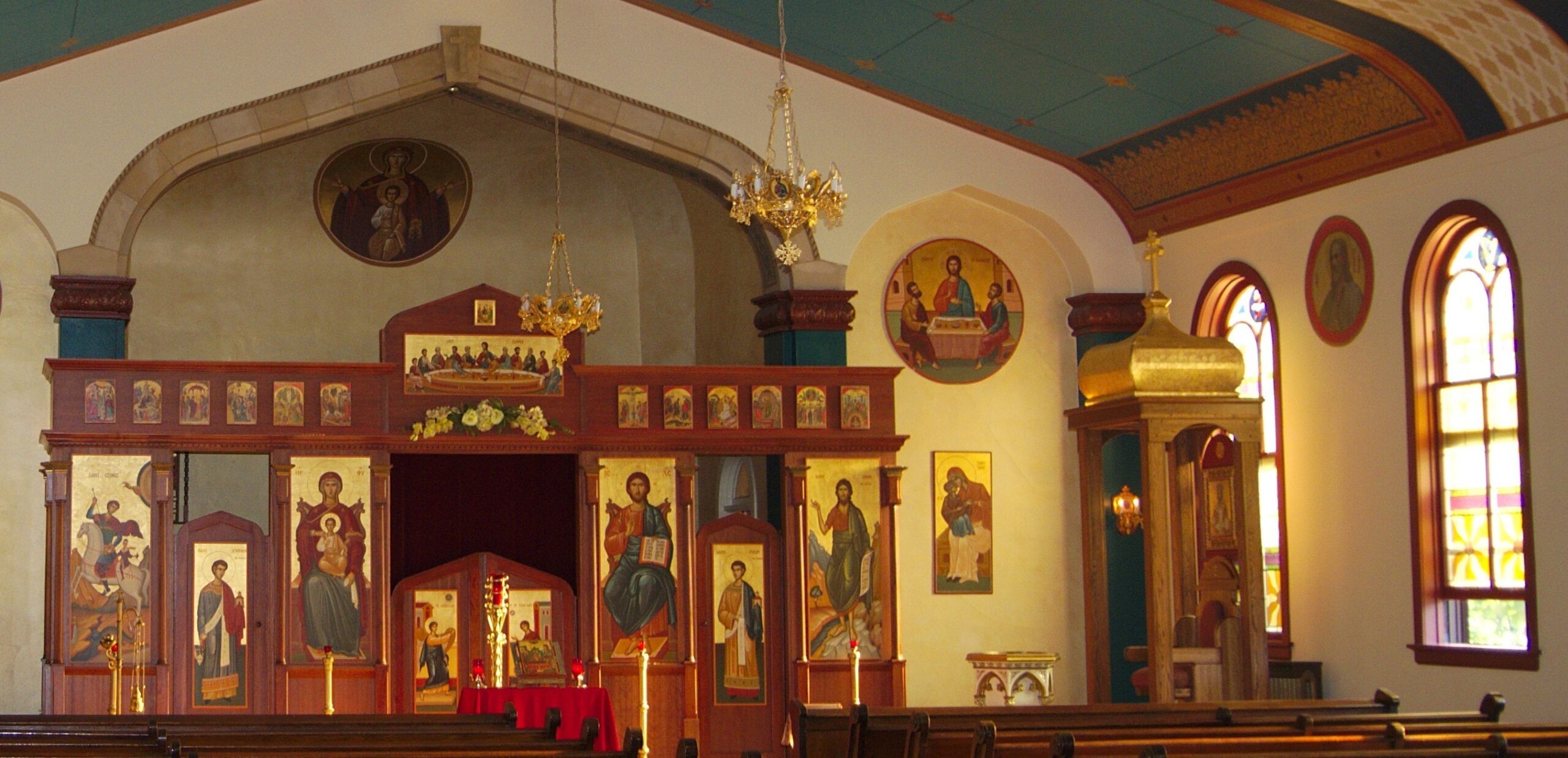1893 – A group from Ain Bourdai, in Lebanon participates at the Columbian Exhibition in Chicago, re-creating Middle Eastern village life. Around this time, one of the men takes a day trip to Milwaukee and decides to settle there.
1900 – Archimandrite John Haddad, pastor of the Melkite-Greek Catholic Church in Chicago begins to make regular visits to Milwaukee.
1911 – Father Timothy Jock organizes the Melkite Catholics in the city and regular worship begins in a rented hall on State Street. He is named pastor of the Syrian Mission. Father Jock also serves as chaplain at the convent of the School Sisters of Notre Dame, where he resides.
1916 – Exarch Anthony Aneid arrives as successor to Fr. Jock. Fr. Aneid spearheads the construction of the new St. George Church on 16th & State. Renowned architect Erhard Brielmaier, who designed thousands of churches in the U.S. and Canada was the architect for the new church.
Thus, the church was decorated entirely in the style of the Latin Rite, and various foreign customs, such as First Holy Communion, Stations of the Cross, etc. were instituted.
Exarch Aneid was succeeded by Archimandrite Joseph Kandalaft, Fr. Peter Nahas and Fr. Raphael Gedah, BSO. Throughout this era the church on State St. remained a center of activity for the Syrian-Lebanese community, but towards the 1960’s most of the parishioners had moved away from the area which began a steep decline. Throughout all this time the parish continued under the jurisdiction of the Roman Catholic Archdiocese of Milwaukee. [Groups of Eastern Catholic immigrants who have no jurisdiction of their own Church, are under the egis of the local Latin Rite hierarchy until a diocese is erected for them.]
In 1967, Pope Paul VI appointed Bishop Just Najmy as the first Melkite bishop for the United States. He had been pastor of the Melkite parishes in Rhode Island and was familiar with the situation of the far-flung Melkite communities throughout the country. In 1969 he was succeeded by Archbishop Joseph Tawil, a native of Damascus.
Archbishop Joseph transformed the Melkite Church in America from a collection of loosely organized enclaves into a vibrant Eastern Catholic Church. Visiting parish after parish he insisted on returning to proper Byzantine liturgical and spiritual practices.
In 1969 he sent a young and energetic priest, Fr. Ronald Golini, to Milwaukee. By this time the church was in a deplorable physical state. Only a handful of people attended the Sunday Divine Liturgy. Father Ron worked to repair and improve the church building and to revive the Melkite Catholic Community. During his tenure at St. George he transformed the dilapidated church into a beautiful Byzantine Catholic temple with the help of many willing hands. Arriving at a time when St. George very likely would have closed forever, Father Golini—under the inspiration of Archbishop Tawil—laid a solid cornerstone on which succeeding pastors have built a firm legacy of Eastern Catholic tradition and life.
Father Alexander Kelliher, SA, a Melkite Franciscan Friar, served as interim pastor until Fr. Damon Geiger, O.Ss.T. arrived in 1975 with two monks. Father Damon did much to enhance the spiritual life of the parish with additional opportunities for worship, and the example of monastic life in the parish.
Father Frank Milienewicz was assigned as pastor in 1982. Under Fr. Frank’s pastorate the education of youth and improvements in the church and rectory took place. While the neighborhood continued to decline, Father Frank’s emphasis was on serving the poor of the area rather than seeking “greener pastures.” Fr. Paul Frechette arrived in 1987 and served until 1991 when he was assigned as rector of St. Gregory the Theologian Seminary in Newton, MA. While at St. George Father Paul instituted adult religious ed, started an excellent parish library, and became active in the local American Syrian Lebanese Club.
In 1991 Fr. Cyril Crume was named pastor. He remained for only two years before resigning due to poor health. After his term, no permanent priest was available to take over the reins. Deacon Dimitry Kamolov who had been serving the parish for several years was asked to take over administration of the parish until a pastor could be assigned. Deacon Dimitry did a remarkable job of holding the parish together, securing the services of biritual priests, and maintaining a strong and committed Pastoral Council and religious ed program.
Fr. Philaret Littlefield, former hegumen of the Melkite Monastery of Our Savior was assigned pastor in 1995. Previously he had been pastor of Holy Trinity Mission in Zanesville, OH and Holy Resurrection in Columbus, OH. After three years without a resident priest, the parish was ready to welcome Fr. Philaret and resume a full and steady liturgical life.
In 2011 Archbishop Cyril approved the solemn profession of vows of Nun Callista, according to the Byzantine Rite. Mother Callista had been serving as sacristan of the church, and has also taken over as parish secretary, and spiritual advisor for our ladies’ society. As a solitary nun living in the world, Mother follows the Studite Rule and devotes her life to prayer and service.
Today the community consists of approximately fifty households. There is an active Pastoral Council, Property Council and Finance Council, the St. Anne Ladies Society, Men’s Study Group, Eastern Christian Formation for children and adults. The parish participates in the wider community with annual clothing and toy collections and other charitable work. The church itself is a national and local landmark. Tours are given throughout the year, which helps people to learn about our Eastern heritage. And the parish has much interaction with the community of Marquette University—our nearest neighbor.

